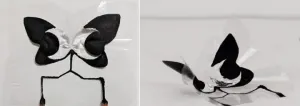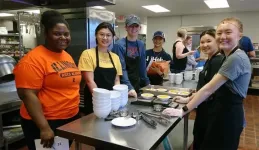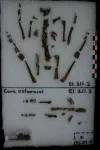Origami comes to life with new shape-changing materials
2021-07-21
(Press-News.org) Imagine opening up a book of nature photos only to see a kaleidoscope of graceful butterflies flutter out from the page.
Such fanciful storybooks might soon be possible thanks to the work of a team of designers and engineers at CU Boulder's ATLAS Institute. The group is drawing from new advancements in the field of soft robotics to develop shape-changing objects that are paper-thin, fast-moving and almost completely silent.
The researchers' early creations, which they've dubbed "Electriflow," include origami cranes that can bend their necks, flower petals that wiggle with the touch of a button and, yes, fluttering insects.
"Usually, books about butterflies are static," said Purnendu, a graduate student at CU Boulder who is leading the project and who goes by a singular name. "But could you have a butterfly flap its wings within a book? We've shown that it's possible."
He and his colleagues presented their results recently at the Association for Computing Machinery's 2021 Designing Interactive Systems (DIS) conference.
Artificial muscles
Purnendu explained that the team's Electriflow designs don't require motors or other traditional machine parts to come to life--making them soft to the touch, just like real butterflies. They're inspired by a class of "artificial muscles" that were initially developed by engineers led by Chrisoph Keplinger at CU Boulder and are now available commercially through a company called Artimus Robotics.
Artimus taps into a technology called hydraulically amplified self-healing electrostatic (HASEL) actuators. Unlike traditional robotic parts, which are often made of rigid metal, HASEL actuators get their power from fluids. The actuators rely on electrostatic forces to push oil around in sealed plastic pouches, said Eric Acome, a former CU Boulder graduate student who helped to pioneer the actuator technology. Picture how the shape of a ketchup packet will change when you squeeze one side.
"One of the main benefits of these actuators is that they're versatile," said Acome, coauthor of the new study and the chief technology officer at Artimus Robotics. "They're just pouches, but depending on the shape of that pouch, you can generate different kinds of movement."
They also emulate the natural world in which organisms of all kinds (think pufferfish or Venus fly traps) change their shapes to scare away predators and trap prey.
"Shape changing is a big part of communication and survival for certain animals," Purnendu said. "Engineers have been on a quest to develop similar kinds of functions for computer interfaces."
Wing flaps
Purnendu wondered if he could use the same concept as Artimus Robotics, or oils sloshing around inside pouches, not to just build new robots but to design soft, movable artwork.
Electriflow takes advantage of several different pouch shapes to create origami-like folds in flat plastic sheets. And it's fast: Purnendu's insects can beat their wings at a top speed of about 25 beats per second--quicker than most real butterflies and on par with some speedier moths.
"This system is very close to what we see in nature," he said. "We're pushing the boundaries of how humans and machines can interact."
The researcher said he hopes more artists and designers will use the tools he and his team developed to push those boundaries even farther. He imagines that one day, you might see origami animals that can fold themselves into various shapes from a flat sheet of plastic or cartoon characters that run and jump in the pages of books.
"There are a lot of different geometries that we can play with," Purnendu said.
For now, he's happy to watch his butterflies take flight.
INFORMATION:
Other coauthors of the new study include Christoph Keplinger, now at the Max Planck Institute for Intelligent Systems in Germany. CU Boulder coauthors include Sasha Novack, graduate student in ATLAS; Mirela Alistair and Daniel Leithinger, assistant professors in ATLAS and the Department of Computer Science; Carson Bruns, assistant professor in ATLAS and mechanical engineering; and Mark Gross, director of ATLAS and professor of computer science.
[Attachments] See images for this press release:

ELSE PRESS RELEASES FROM THIS DATE:
2021-07-21
Alexandria, Va., USA - IADR President Pamela Den Besten presented and chaired the IADR President's Symposium "Enamel Defects as Biomarkers for Exposure to Environmental Stressors" at the virtual 99th General Session & Exhibition of the International Association for Dental Research (IADR), held in conjunction with the 50th Annual Meeting of the American Association for Dental Research (AADR) and the 45th Annual Meeting of the Canadian Association for Dental Research (CADR), on July 21-24, 2021.
Enamel pathologies may result from mutations of genes involved in amelogenesis, or from specific environmental ...
2021-07-21
Alexandria, Va., USA - Muthuthanthrige Cooray, Tohoku University, Sendai, Japan, presented the oral session "Oral and General Health Associations Using Machine Learning Prediction Algorithms" at the virtual 99th General Session & Exhibition of the International Association for Dental Research (IADR), held in conjunction with the 50th Annual Meeting of the American Association for Dental Research (AADR) and the 45th Annual Meeting of the Canadian Association for Dental Research (CADR), on July 21-24, 2021.
General health and oral health are conventionally treated as separate entities within the healthcare delivery, however most general health and oral health problems share common ...
2021-07-21
In the race to combat climate change, capturing carbon dioxide (CO2) emissions has been touted as a simple road to reach net-zero emissions by 2050. While the science behind carbon capture is sound, current technologies are expensive and not optimized for all settings. A cover story in Chemical & Engineering News, the weekly newsmagazine of the American Chemical Society, highlights the current state of carbon capture and work being done to improve the process.
Although efficiency improvements and renewable power sources can help, they are often expensive and will not be enough to counter the billions of tons of CO2 sent into the atmosphere each year, writes Associate ...
2021-07-21
URBANA, Ill. - When kids sit down to eat lunch at school, fruits and vegetables may not be their first choice. But with more time at the lunch table, they are more likely to pick up those healthy foods. If we want to improve children's nutrition and health, ensuring longer school lunch breaks can help achieve those goals, according to research from the University of Illinois.
"Ten minutes of seated lunch time or less is quite common. Scheduled lunch time may be longer, but students have to wait in line to get their food. And sometimes lunch periods are shared with recess. This means the amount of time children actually have to eat their meals is much less than the scheduled time," says ...
2021-07-21
COLUMBUS, Ohio - The oral targeted therapy drug ibrutinib is an effective treatment option for high-risk hairy cell leukemia, according to a new study conducted by researchers at The Ohio State University Comprehensive Cancer Center - Arthur G. James Cancer Hospital and Richard J. Solove Research Institute (OSUCCC - James).
Hairy cell leukemia is a rare form of B-cell blood cancer that is diagnosed in 600 to 800 people annually in the United States. Researchers note that while the disease generally has a good prognosis for the majority of people affected, ...
2021-07-21
Domesticated rabbits come in all sizes and colors, including tiny Netherland Dwarfs, floppy-eared French lops, Flemish Giants, and fluffy Angoras.
These breeds belong to Europe's only rabbit species, originally limited to the Iberian Peninsula and Southern France and used for meat and fur since the last Ice Age, culminating in domestication about 1,500 years ago.
The Americas, on the other hand, have many rabbit species with ranges throughout both continents. The archaeological record shows rabbits were used as extensively in the Americas as they were on the Iberian Peninsula, with clear archaeological evidence that rabbits were being deliberately raised. Why, then, were rabbits domesticated in Europe and not the Americas?
Recent work ...
2021-07-21
A new University of Chicago study has found that the drug masitinib may be effective in treating COVID-19.
The drug, which has undergone several clinical trials for human conditions but has not yet received approval to treat humans, inhibited the replication of SARS-CoV-2 in human cell cultures and in a mouse model, leading to much lower viral loads.
Researchers at UChicago's Pritzker School of Molecular Engineering (PME), working with collaborators at Argonne National Laboratory and around the world, also found that the drug could be effective against many types of coronaviruses and picornaviruses. Because of the way it inhibits replication, it ...
2021-07-21
Older people appear to have fewer antibodies against the novel coronavirus, a new laboratory study from Oregon Health & Science University suggests.
Antibodies are blood proteins that are made by the immune system to protect against infection. They are known to be key players in protection against SARS-CoV-2 infection.
The study published today in the Journal of the American Medical Association.
"Our older populations are potentially more susceptible to the variants even if they are vaccinated," said senior author Fikadu Tafesse, Ph.D., assistant professor of molecular microbiology and immunology in the OHSU School of Medicine.
Tafesse and colleagues emphasized that even though they measured diminished antibody ...
2021-07-21
The average American spends 5 days each year in line by some estimates. Many of these lines are for things like a cup of coffee, movie theater tickets or a ride on the newest roller coaster, but for some the wait is for something far more pressing -- a new kidney.
In South Carolina, the average time spent on a waitlist for a kidney transplant is 42 months, but according to a recent paper in JAMA Surgery, changes to the U.S. kidney allocation system could result in reduced access to kidney transplants and longer times spent in line.
"At face value, the changes in the allocation system seem quite appropriate," said Derek DuBay, M.D., director of ...
2021-07-21
Common yeast are able to adapt and thrive in response to a long-term rise in temperature by changing the shape, location and function of some of their proteins. The surprising findings demonstrate the unappreciated plasticity in the molecular and conformational level of proteins and bring the power of molecular biology to the organismal response to climate change. Results from the Zhou lab at the Buck Institute in collaboration with the Si lab from the Stowers Institute are published in Molecular Cell.
Temperature is an unstable parameter in the wild, affecting almost ...
LAST 30 PRESS RELEASES:
[Press-News.org] Origami comes to life with new shape-changing materials



